|
|
|---|
Monday, October 25, 2010
International Red Cross and Red Crescent Movement At This Time-
Activities and organization of the Federation:
The American Red Cross involvement in World War II preceded the entrance of the United States into the conflict. When hostilities began in Europe in 1939.
The first of these conventions involved the sick and wounded. The Red Cross established auxiliary hospitals where they were allowed to and staffed them with Red Cross personnel. They were neutral and treated anyone caught up in a conflict wherever this was. It was an international expectation that warring nations would treat Red Cross personnel in the appropriate manner and that the hospitals were not legitimate targets. The Red Cross also established convalescent homes to look after the sick if they needed long term care.
The other convention in existence at the time involved POW's and their treatment. This convention also extended to internees held by a warring nation. In 1934, the International Red Cross had attempted to get all nations to agree to legal safeguards for all civilians in an area where war had broken out. International powers agreed to defer agreement on this until 1940. Therefore, when World War Two broke out, many civilians had no safe-guarded legal rights. The Red Cross never stopped trying to access those who were arrested, deported or sent into forced labour but with little success.
Article 79 of the Convention allowed the Red Cross to pass on information or enquiries about POW's. These 'letters' were restricted to just 25 words and had to be about family news only. All messages were sent to the International Red Cross headquarters in Geneva from where they were sent on to their respective destinations. By 1945, 24 million messages had been exchanged. The International Red Cross was also empowered to collect all information they could about POW's - such as their whereabouts, health etc.
The Mission of the Federation and its responsibilities within the Movement-
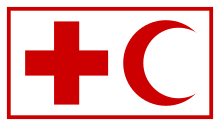
Emblem of the Federation
The Federation coordinates cooperation between national Red Cross and Red Crescent societies throughout the world and supports the foundation of new national societies in countries where no official society exists. On the international stage, the Federation organizes and leads relief assistance missions after emergencies like natural disasters, manmade disasters, epidemics, mass refugee flights, and other emergencies. According to the 1997 Seville Agreement, the Federation is the Lead Agency of the Movement in any emergency situation which does not take place as part of an armed conflict. The Federation cooperates with the national societies of those countries affected – each called the Operating National Society (ONS) – as well as the national societies of other countries willing to offer assistance – called Participating National Societies (PNS). Among the 187 national societies admitted to the General Assembly of the Federation as full members or observers, about 25–30 regularly work as PNS in other countries. The most active of those are the American Red Cross, the British Red Cross, the German Red Cross, and the Red Cross societies of Sweden and Norway. Another major mission of the Federation which has gained attention in recent years is its commitment to work towards a codified, worldwide ban on the use of land mines and to bring medical, psychological, and social support for people injured by land mines.
Funding and financial matters-
The main parts of the budget of the Federation are funded by contributions from the national societies which are members of the Federation and through revenues from its investments. The exact amount of contributions from each member society is established by the Finance Commission and approved by the General Assembly. Any additional funding, especially for unforeseen expenses for relief assistance missions, is raised by appeals published by the Federation and comes from voluntary donations by national societies, governments, other organizations, corporations, and individuals.
National societies within the Movement:
Official Recognition of a national society-

An ambulance owned by the Mexican Red Cross
National Red Cross and Red Crescent societies exist in nearly every country in the world. Within their home country, they take on the duties and responsibilities of a national relief society as defined by International Humanitarian Law. Within the Movement, the ICRC is responsible for legally recognizing a relief society as an official national Red Cross or Red Crescent society. The exact rules for recognition are defined in the statutes of the Movement. Article 4 of these statutes contains the "Conditions for recognition of National Societies"
- "Red Cross" redirects here. For other uses, see Red Cross (disambiguation).
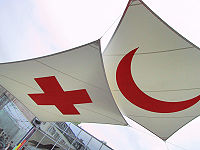 The Red Cross and Red Crescent emblems, the symbols from which the movement derives its name. | |||||||||
| Founders | Henry Dunant | ||||||||
|---|---|---|---|---|---|---|---|---|---|
| Founded | 1863 | ||||||||
| Location | Geneva, Switzerland | ||||||||
| Area served | Worldwide | ||||||||
| Focus | Humanitarian | ||||||||
| Method | Aid | ||||||||
| Website | http://www.redcross.int/ | ||||||||
The International Red Cross and Red Crescent Movement is an international humanitarian movement with approximately 97 million volunteers, members and staff worldwide which was founded to protect human life and health, to ensure respect for all human beings, and to prevent and alleviate human suffering, without any discrimination based on nationality, race, sex, religious beliefs, class or political opinions.
The often-heard term International Red Cross is actually a misnomer, as no official organization as such exists bearing that name. In reality, the movement consists of several distinct organizations that are legally independent from each other, but are united within the Movement through common basic principles, objectives, symbols, statutes and governing organs. The Movement's parts:
- The International Committee of the Red Cross (ICRC) is a private humanitarian institution founded in 1863 in Geneva, Switzerland, by Henry Dunant. Its 25-member committee has a unique authority under international humanitarian law to protect the life and dignity of the victims of international and internal armed conflicts. The ICRC was awarded the Nobel Peace Prize on three occasions (in 1917, 1944 and 1963).
- The International Federation of Red Cross and Red Crescent Societies (IFRC) was founded in 1919 and today it coordinates activities between the 186 National Red Cross and Red Crescent Societies within the Movement. On an international level, the Federation leads and organizes, in close cooperation with the National Societies, relief assistance missions responding to large-scale emergencies. The International Federation Secretariat is based in Geneva, Switzerland. In 1963, the Federation (then known as the League of Red Cross Societies) was awarded the Nobel Peace Prize jointly with the ICRC.
- National Red Cross and Red Crescent Societies exist in nearly every country in the world. Currently 186 National Societies are recognized by the ICRC and admitted as full members of the Federation. Each entity works in its home country according to the principles of international humanitarian law and the statutes of the international Movement. Depending on their specific circumstances and capacities, National Societies can take on additional humanitarian tasks that are not directly defined by international humanitarian law or the mandates of the international Movement. In many countries, they are tightly linked to the respective national health care system by providing emergency medical services.
History of Movement:
The International Committee of the Red Cross-
Solferino, Henry Dunant and the foundation of the ICRC-

Henry Dunant, author of "A Memory of Solferino"
Until the middle of the 19th century, there were no organized and/or well-established army nursing systems for casualties and no safe and protected institutions to accommodate and treat those who were wounded on the battlefield. In June 1859, the Swiss businessman Henry Dunant traveled to Italy to meet French emperor Napoléon III with the intention of discussing difficulties in conducting business in Algeria, at that time occupied by France. When he arrived in the small town of Solferino on the evening of June 24, he witnessed the Battle of Solferino, an engagement in the Austro-Sardinian War. In a single day, about 40,000 soldiers on both sides died or were left wounded on the field. Henry Dunant was shocked by the terrible aftermath of the battle, the suffering of the wounded soldiers, and the near-total lack of medical attendance and basic care. He completely abandoned the original intent of his trip and for several days he devoted himself to helping with the treatment and care for the wounded. He succeeded in organizing an overwhelming level of relief assistance by motivating the local population to aid without discrimination. Back in his home in Geneva, he decided to write a book entitled A Memory of Solferino which he published with his own money in 1862. He sent copies of the book to leading political and military figures throughout Europe. In addition to penning a vivid description of his experiences in Solferino in 1859, he explicitly advocated the formation of national voluntary relief organizations to help nurse wounded soldiers in the case of war. In addition, he called for the development of international treaties to guarantee the protection of neutral medics and field hospitals for soldiers wounded on the battlefield.
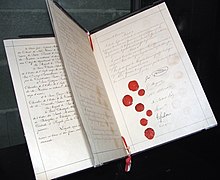
Original document of the first Geneva Convention, 1864
On February 9, 1863, in Geneva, Henry Dunant founded the "Committee of the Five" (together with four other leading figures from well-known Geneva families) as an investigatory commission of the Geneva Society for Public Welfare. Their aim was to examine the feasibility of Dunant's ideas and to organize an international conference about their possible implementation. The members of this committee, aside from Dunant himself, were Gustave Moynier, lawyer and chairman of the Geneva Society for Public Welfare; physician Louis Appia, who had significant experience working as a field surgeon; Appia's friend and colleague Théodore Maunoir, from the Geneva Hygiene and Health Commission; and Guillaume-Henri Dufour, a Swiss Army general of great renown. Eight days later, the five men decided to rename the committee to the "International Committee for Relief to the Wounded". In October (26–29) 1863, the international conference organized by the committee was held in Geneva to develop possible measures to improve medical services on the battlefield. The conference was attended by 36 individuals: eighteen official delegates from national governments, six delegates from other non-governmental organizations, seven non-official foreign delegates, and the five members of the International Committee. The states and kingdoms represented by official delegates were:
 Austria
Austria Baden
Baden Bavaria
Bavaria France
France Hanover
Hanover Hesse-Kassel
Hesse-Kassel Italy
Italy The Netherlands
The Netherlands Prussia
Prussia Russian Empire
Russian Empire Saxony
Saxony Spain
Spain Sweden-Norway
Sweden-Norway United Kingdom
United Kingdom
Among the proposals written in the final resolutions of the conference, adopted on October 29, 1863, were:
- The foundation of national relief societies for wounded soldiers;
- Neutrality and protection for wounded soldiers;
- The utilization of volunteer forces for relief assistance on the battlefield;
- The organization of additional conferences to enact these concepts in legally binding international treaties; and
- The introduction of a common distinctive protection symbol for medical personnel in the field, namely a white armlet bearing a red cross.

Memorial commemorating the first use of the Red Cross symbol in an armed conflict during the Battle of Dybbøl (Denmark) in 1864; jointly erected in 1989 by the national Red Cross societies of Denmark and Germany.
Only one year later, the Swiss government invited the governments of all European countries, as well as the United States, Brazil, and Mexico, to attend an official diplomatic conference. Sixteen countries sent a total of twenty-six delegates to Geneva. On August 22, 1864, the conference adopted the first Geneva Convention "for the Amelioration of the Condition of the Wounded in Armies in the Field". Representatives of 12 states and kingdoms signed the convention: Baden, Belgium, Denmark, France, Hesse, Italy, the Netherlands, Portugal, Prussia, Switzerland, Spain, and Württemberg. The convention contained ten articles, establishing for the first time legally binding rules guaranteeing neutrality and protection for wounded soldiers, field medical personnel, and specific humanitarian institutions in an armed conflict. Furthermore, the convention defined two specific requirements for recognition of a national relief society by the International Committee:
- The national society must be recognized by its own national government as a relief society according to the convention, and
- The national government of the respective country must be a state party to the Geneva Convention.
Directly following the establishment of the Geneva Convention, the first national societies were founded in Belgium, Denmark, France, Oldenburg, Prussia, Spain, and Württemberg. Also in 1864, Louis Appia and Charles van de Velde, a captain of the Dutch Army, became the first independent and neutral delegates to work under the symbol of the Red Cross in an armed conflict. Three years later in 1867, the first International Conference of National Aid Societies for the Nursing of the War Wounded was convened.
Also in 1867, Henry Dunant was forced to declare bankruptcy due to business failures in Algeria, partly because he had neglected his business interests during his tireless activities for the International Committee. Controversy surrounding Dunant's business dealings and the resulting negative public opinion, combined with an ongoing conflict with Gustave Moynier, led to Dunant's expulsion from his position as a member and secretary. He was charged with fraudulent bankruptcy and a warrant for his arrest was issued. Thus, he was forced to leave Geneva and never returned to his home city. In the following years, national societies were founded in nearly every country in Europe. In 1876, the committee adopted the name "International Committee of the Red Cross" (ICRC), which is still its official designation today. Five years later, the American Red Cross was founded through the efforts of Clara Barton. More and more countries signed the Geneva Convention and began to respect it in practice during armed conflicts. In a rather short period of time, the Red Cross gained huge momentum as an internationally respected movement, and the national societies became increasingly popular as a venue for volunteer work.
When the first Nobel Peace Prize was awarded in 1901, the Norwegian Nobel Committee opted to give it jointly to Henry Dunant and Frédéric Passy, a leading international pacifist. More significant than the honor of the prize itself, the official congratulation from the International Committee of the Red Cross marked the overdue rehabilitation of Henry Dunant and represented a tribute to his key role in the formation of the Red Cross. Dunant died nine years later in the small Swiss health resort of Heiden. Only two months earlier his long-standing adversary Gustave Moynier had also died, leaving a mark in the history of the Committee as its longest-serving president ever.
In 1906, the 1864 Geneva Convention was revised for the first time. One year later, the Hague Convention X, adopted at the Second International Peace Conference in The Hague, extended the scope of the Geneva Convention to naval warfare. Shortly before the beginning of the First World War in 1914, 50 years after the foundation of the ICRC and the adoption of the first Geneva Convention, there were already 45 national relief societies throughout the world. The movement had extended itself beyond Europe and North America to Central and South America (Argentina, Brazil, Chile, Cuba, Mexico, Peru, El Salvador, Uruguay, Venezuela), Asia (the Republic of China, Japan, Korea, Siam), and Africa (Republic of South Africa).
The ICRC during World War I-

French postcard celebrating the role of Red Cross nurses during the First World War, 1915

Ernest Hemingway in uniform as a Red Cross ambulance driver
With the outbreak of World War I, the ICRC found itself confronted with enormous challenges that it could handle only by working closely with the national Red Cross societies. Red Cross nurses from around the world, including the United States and Japan, came to support the medical services of the armed forces of the European countries involved in the war. On October 15, 1914, immediately after the start of the war, the ICRC set up its International Prisoners-of-War (POW) Agency, which had about 1,200 mostly volunteer staff members by the end of 1914. By the end of the war, the Agency had transferred about 20 million letters and messages, 1.9 million parcels, and about 18 million Swiss francs in monetary donations to POWs of all affected countries. Furthermore, due to the intervention of the Agency, about 200,000 prisoners were exchanged between the warring parties, released from captivity and returned to their home country. The organizational card index of the Agency accumulated about 7 million records from 1914 to 1923, each card representing an individual prisoner or missing person. The card index led to the identification of about 2 million POWs and the ability to contact their families. The complete index is on loan today from the ICRC to the International Red Cross and Red Crescent Museum in Geneva. The right to access the index is still strictly restricted to the ICRC.

French war casualty wearing a prosthetic mask provided by the American Red Cross, 1918

The same man without his mask
During the entire war, the ICRC monitored warring parties’ compliance with the Geneva Conventions of the 1907 revision and forwarded complaints about violations to the respective country. When chemical weapons were used in this war for the first time in history, the ICRC vigorously protested against this new type of warfare. Even without having a mandate from the Geneva Conventions, the ICRC tried to ameliorate the suffering of civil populations. In territories that were officially designated as "occupied
territories," the ICRC could assist the civilian population on the basis of the Hague Convention's "Laws and Customs of War on Land" of 1907. This convention was also the legal basis for the ICRC's work for prisoners of war. In addition to the work of the International Prisoner-of-War Agency as described above this included inspection visits to POW camps. A total of 524 camps throughout Europe were visited by 41 delegates from the ICRC until the end of the war.
Between 1916 and 1918, the ICRC published a number of postcards with scenes from the POW camps. The pictures showed the prisoners in day-to-day activities such as the distribution of letters from home. The intention of the ICRC was to provide the families of the prisoners with some hope and solace and to alleviate their uncertainties about the fate of their loved ones. After the end of the war, the ICRC organized the return of about 420,000 prisoners to their home countries. In 1920, the task of repatriation was handed over to the newly founded League of Nations, which appointed the Norwegian diplomat and scientist Fridtjof Nansen as its "High Commissioner for Repatriation of the War Prisoners." His legal mandate was later extended to support and care for war refugees and displaced persons when his office became that of the League of Nations "High Commissioner for Refugees." Nansen, who invented the Nansen passport for stateless refugees and was awarded the Nobel Peace Prize in 1922, appointed two delegates from the ICRC as his deputies.
A year before the end of the war, the ICRC received the 1917 Nobel Peace Prize for its outstanding wartime work. It was the only Nobel Peace Prize awarded in the period from 1914 to 1918. In 1923, the Committee adopted a change in its policy regarding the selection of new members. Until then, only citizens from the city of Geneva could serve in the Committee. This limitation was expanded to include Swiss citizens. As a direct consequence of World War I, an additional protocol to the Geneva Convention was adopted in 1925 which outlawed the use of suffocating or poisonous gases and biological agents as weapons. Four years later, the original Convention was revised and the second Geneva Convention "relative to the Treatment of Prisoners of War" was established. The events of World War I and the respective activities of the ICRC significantly increased the reputation and authority of the Committee among the international community and led to an extension of its competencies.
As early as in 1934, a draft proposal for an additional convention for the protection of the civil population during an armed conflict was adopted by the International Red Cross Conference. Unfortunately, most governments had little interest in implementing this convention, and it was thus prevented from entering into force before the beginning of World War II.
The ICRC and World War II-
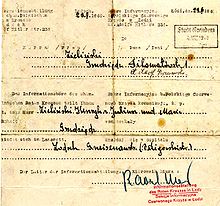
Red Cross message from Łódź, Poland, 1940.
The legal basis of the work of the ICRC during World War II were the Geneva Conventions in their 1929 revision. The activities of the Committee were similar to those during World War I: visiting and monitoring POW camps, organizing relief assistance for civilian populations, and administering the exchange of messages regarding prisoners and missing persons. By the end of the war, 179 delegates had conducted 12,750 visits to POW camps in 41 countries. The Central Information Agency on Prisoners-of-War (Zentralauskunftsstelle für Kriegsgefangene) had a staff of 3,000, the card index tracking prisoners contained 45 million cards, and 120 million messages were exchanged by the Agency. One major obstacle was that the Nazi-controlled German Red Cross refused to cooperate with the Geneva statutes including blatant violations such as the deportation of Jews from Germany and the mass murders conducted in the Nazi concentration camps. Moreover, two other main parties to the conflict, the Soviet Union and Japan, were not party to the 1929 Geneva Conventions and were not legally required to follow the rules of the conventions.
During the war, the ICRC was unable to obtain an agreement with Nazi Germany about the treatment of detainees in concentration camps, and it eventually abandoned applying pressure in order to avoid disrupting its work with POWs. The ICRC was also unable to obtain a response to reliable information about the extermination camps and the mass killing of European Jews, Roma, et al. After November 1943, the ICRC achieved permission to send parcels to concentration camp detainees with known names and locations. Because the notices of receipt for these parcels were often signed by other inmates, the ICRC managed to register the identities of about 105,000 detainees in the concentration camps and delivered about 1.1 million parcels, primarily to the camps Dachau, Buchenwald, Ravensbrück, and Sachsenhausen.
It is known that Swiss army officer Maurice Rossel during World War II had been sent to Berlin as a delegate of the International Red Cross, as such he visited Auschwitz 1943 and Theresienstadt 1944. Claude Lanzmann recorded his experiences in 1979, producing a documentary entitled Visitor from the living.

Marcel Junod, delegate of the ICRC, visiting POWs in Germany.
(© Benoit Junod, Switzerland)
(© Benoit Junod, Switzerland)
On March 12, 1945, ICRC president Jacob Burckhardt received a message from SS General Ernst Kaltenbrunner accepting the ICRC's demand to allow delegates to visit the concentration camps. This agreement was bound by the condition that these delegates would have to stay in the camps until the end of the war. Ten delegates, among them Louis Haefliger (Camp Mauthausen), Paul Dunant (Camp Theresienstadt) and Victor Maurer (Camp Dachau), accepted the assignment and visited the camps. Louis Haefliger prevented the forceful eviction or blasting of Mauthausen-Gusen by alerting American troops, thereby saving the lives of about 60,000 inmates. His actions were condemned by the ICRC because they were deemed as acting unduly on his own authority and risking the ICRC's neutrality. Only in 1990, his reputation was finally rehabilitated by ICRC president Cornelio Sommaruga.
Another example of great humanitarian spirit was Friedrich Born (1903–1963), an ICRC delegate in Budapest who saved the lives of about 11,000 to 15,000 Jewish people in Hungary. Marcel Junod (1904–1961), a physician from Geneva, was another famous delegate during the Second World War. An account of his experiences, which included being one of the first foreigners to visit Hiroshima after the atomic bomb was dropped, can be found in the book Warrior without Weapons.
In 1944, the ICRC received its second Nobel Peace Prize. As in World War I, it received the only Peace Prize awarded during the main period of war, 1939 to 1945. At the end of the war, the ICRC worked with national Red Cross societies to organize relief assistance to those countries most severely affected. In 1948, the Committee published a report reviewing its war-era activities from September 1, 1939 to June 30, 1947. Since January 1996, the ICRC archive for this period has been open to academic and public research.
The ICRC after the Second World War-

The ICRC Headquarters in Geneva
On August 12, 1949, further revisions to the existing two Geneva Conventions were adopted. An additional convention "for the Amelioration of the Condition of Wounded, Sick and Shipwrecked Members of Armed Forces at Sea", now called the second Geneva Convention, was brought under the Geneva Convention umbrella as a successor to the 1907 Hague Convention X. The 1929 Geneva convention "relative to the Treatment of Prisoners of War" may have been the second Geneva Convention from a historical point of view (because it was actually formulated in Geneva), but after 1949 it came to be called the third Convention because it came later chronologically than the Hague Convention. Reacting to the experience of World War II, the Fourth Geneva Convention, a new Convention "relative to the Protection of Civilian Persons in Time of War," was established. Also, the additional protocols of June 8, 1977 were intended to make the conventions apply to internal conflicts such as civil wars. Today, the four conventions and their added protocols contain more than 600 articles, a remarkable expansion when compared to the mere 10 articles in the first 1864 convention.
In celebration of its centennial in 1963, the ICRC, together with the League of Red Cross Societies, received its third Nobel Peace Prize. Since 1993, non-Swiss individuals have been allowed to serve as Committee delegates abroad, a task which was previously restricted to Swiss citizens. Indeed, since then, the share of staff without Swiss citizenship has increased to about 35%.
On October 16, 1990, the UN General Assembly decided to grant the ICRC observer status for its assembly sessions and sub-committee meetings, the first observer status given to a private organization. The resolution was jointly proposed by 138 member states and introduced by the Italian ambassador, Vieri Traxler, in memory of the organization's origins in the Battle of Solferino. An agreement with the Swiss government signed on March 19, 1993, affirmed the already long-standing policy of full independence of the Committee from any possible interference by Switzerland. The agreement protects the full sanctity of all ICRC property in Switzerland including its headquarters and archive, grants members and staff legal immunity, exempts the ICRC from all taxes and fees, guarantees the protected and duty-free transfer of goods, services, and money, provides the ICRC with secure communication privileges at the same level as foreign embassies, and simplifies Committee travel in and out of Switzerland.
At the end of the Cold War, the ICRC's work actually became more dangerous. In the 1990s, more delegates lost their lives than at any point in its history, especially when working in local and internal armed conflicts. These incidents often demonstrated a lack of respect for the rules of the Geneva Conventions and their protection symbols. Among the slain delegates were:
- Frédéric Maurice. He died on May 19, 1992 at the age of 39, one day after a Red Cross transport he was escorting was attacked in the Bosnian city of Sarajevo.
- Fernanda Calado (Spain), Ingeborg Foss (Norway), Nancy Malloy (Canada), Gunnhild Myklebust (Norway), Sheryl Thayer (New Zealand), and Hans Elkerbout (Netherlands). They were murdered at point-blank range while sleeping in the early hours of December 17, 1996 in the ICRC field hospital in the Chechen city of Nowije Atagi near Grozny. Their murderers have never been caught and there was no apparent motive for the killings.
- Rita Fox (Switzerland), Véronique Saro (Democratic Republic of Congo, formerly Zaire), Julio Delgado (Colombia), Unen Ufoirworth (DR Congo), Aduwe Boboli (DR Congo), and Jean Molokabonge (DR Congo). On April 26, 2001, they were en route with two cars on a relief mission in the northeast of the Democratic Republic of Congo when they came under fatal fire from unknown attackers.
- Ricardo Munguia (El Salvador). He was working as a water engineer in Afghanistan and travelling with local colleagues when their car on March 27, 2003 was stopped by unknown armed men. He was killed execution-style at point-blank range while his colleagues were allowed to escape. He died at the age of 39.
- Vatche Arslanian (Canada). Since 2001, he worked as a logistics coordinator for the ICRC mission in Iraq. He died when he was travelling through Baghdad together with members of the Iraqi Red Crescent. On April 8, 2003 their car accidentally came into the cross fire of fighting in the city.
- Nadisha Yasassri Ranmuthu (Sri Lanka). He was killed by unknown attackers on July 22, 2003 when his car was fired upon near the city of Hilla in the south of Baghdad.
Afghanistan-
ICRC is active in the Afghanistan conflict areas and has set up six physical rehabilitation centers to help landmine victims. Their support extends to the national and international armed forces, civilians and the armed opposition. They have provided basic first aid training and aid kits to Taliban members as well because, according to an ICRC spokesperson, "ICRC's constitution stipulates that all parties harmed by warfare will be treated as fairly as possible".
The International Federation of Red Cross and Red Crescent Societies:
History-

Henry Davison, Founding father of the League of Red Cross societies.
(Picture from: www.redcross.int)
In 1919, representatives from the national Red Cross societies of Britain, France, Italy, Japan, and the US came together in Paris to found the "League of Red Cross Societies". The original idea was Henry Davison's, then president of the American Red Cross. This move, led by the American Red Cross, expanded the international activities of the Red Cross movement beyond the strict mission of the ICRC to include relief assistance in response to emergency situations which were not caused by war (such as man-made or natural disasters). The ARC already had great disaster relief mission experience extending back to its foundation.
The formation of the League, as an additional international Red Cross organization alongside the ICRC, was not without controversy for a number of reasons. The ICRC had, to some extent, valid concerns about a possible rivalry between both organizations. The foundation of the League was seen as an attempt to undermine the leadership position of the ICRC within the movement and to gradually transfer most of its tasks and competencies to a multilateral institution. In addition to that, all founding members of the League were national societies from countries of the Entente or from associated partners of the Entente. The original statutes of the League from May 1919 contained further regulations which gave the five founding societies a privileged status and, due to the efforts of Henry P. Davison, the right to permanently exclude the national Red Cross societies from the countries of the Central Powers, namely Germany, Austria, Hungary, Bulgaria and Turkey, and in addition to that the national Red Cross society of Russia. These rules were contrary to the Red Cross principles of universality and equality among all national societies, a situation which furthered the concerns of the ICRC.
The first relief assistance mission organized by the League was an aid mission for the victims of a famine and subsequent typhus epidemic in Poland. Only five years after its foundation, the League had already issued 47 donation appeals for missions in 34 countries, an impressive indication of the need for this type of Red Cross work. The total sum raised by these appeals reached 685 million Swiss Francs, which were used to bring emergency supplies to the victims of famines in Russia, Germany, and Albania; earthquakes in Chile, Persia, Japan, Colombia, Ecuador, Costa Rica, and Turkey; and refugee flows in Greece and Turkey. The first large-scale disaster mission of the League came after the 1923 earthquake in Japan which killed about 200,000 people and left countless more wounded and without shelter. Due to the League's coordination, the Red Cross society of Japan received goods from its sister societies reaching a total worth of about $100 million. Another important new field initiated by the League was the creation of youth Red Cross organizations within the national societies.
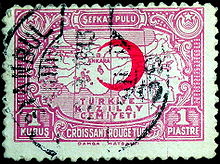
A stamp from Turkey to support the Red Crescent, 1928.
A joint mission of the ICRC and the League in the Russian Civil War from 1917 to 1922 marked the first time the movement was involved in an internal conflict, although still without an explicit mandate from the Geneva Conventions. The League, with support from more than 25 national societies, organized assistance missions and the distribution of food and other aid goods for civil populations affected by hunger and disease. The ICRC worked with the Russian Red Cross society and later the society of the Soviet Union, constantly emphasizing the ICRC's neutrality. In 1928, the "International Council" was founded to coordinate cooperation between the ICRC and the League, a task which was later taken over by the "Standing Commission". In the same year, a common statute for the movement was adopted for the first time, defining the respective roles of the ICRC and the League within the movement.
During the Abyssinian war between Ethiopia and Italy from 1935 to 1936, the League contributed aid supplies worth about 1.7 million Swiss Francs. Because the Italian fascist regime under Benito Mussolini refused any cooperation with the Red Cross, these goods were delivered solely to Ethiopia. During the war, an estimated 29 people lost their lives while being under explicit protection of the Red Cross symbol, most of them due to attacks by the Italian Army. During the Civil War in Spain from 1936 to 1939 the League once again joined forces with the ICRC with the support of 41 national societies. In 1939 on the brink of the Second World War, the League relocated its headquarters from Paris to Geneva to take advantage of Swiss neutrality.
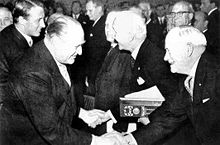
Peace Nobel Prize ceremony in 1963; From left to right: Crown Prince Harald of Norway, King Olav of Norway, ICRC President Leopold Boissier, League Chairman John A. MacAulay.
(Picture from: www.redcross.int)
(Picture from: www.redcross.int)
In 1952, the 1928 common statute of the movement was revised for the first time. Also, the period of decolonization from 1960 to 1970 was marked by a huge jump in the number of recognized national Red Cross and Red Crescent societies. By the end of the 1960s, there were more than 100 societies around the world. On December 10, 1963, the Federation and the ICRC received the Nobel Peace Prize. In 1983, the League was renamed to the "League of Red Cross and Red Crescent Societies" to reflect the growing number of national societies operating under the Red Crescent symbol. Three years later, the seven basic principles of the movement as adopted in 1965 were incorporated into its statutes. The name of the League was changed again in 1991 to its current official designation the "International Federation of Red Cross and Red Crescent Societies". In 1997, the ICRC and the Federation signed the Seville Agreement which further defined the responsibilities of both organizations within the movement. In 2004, the Federation began its largest mission to date after the tsunami disaster in South Asia. More than 40 national societies have worked with more than 22,000 volunteers to bring relief to the countless victims left without food and shelter and endangered by the risk of epidemics.
From Wikipedia-
0 Comments:
Subscribe to:
Post Comments (Atom)















